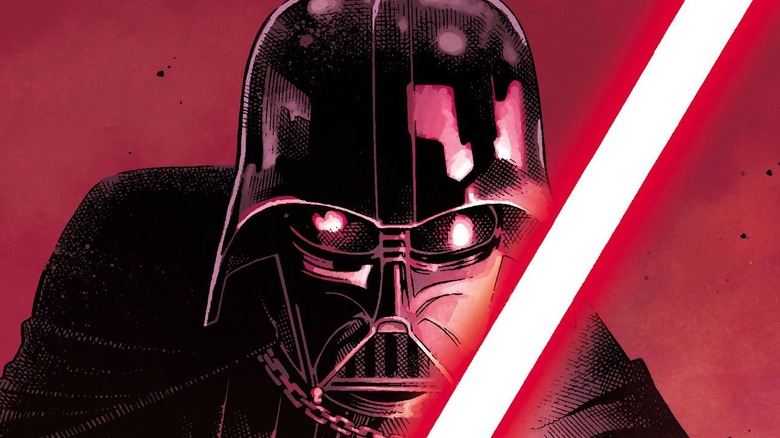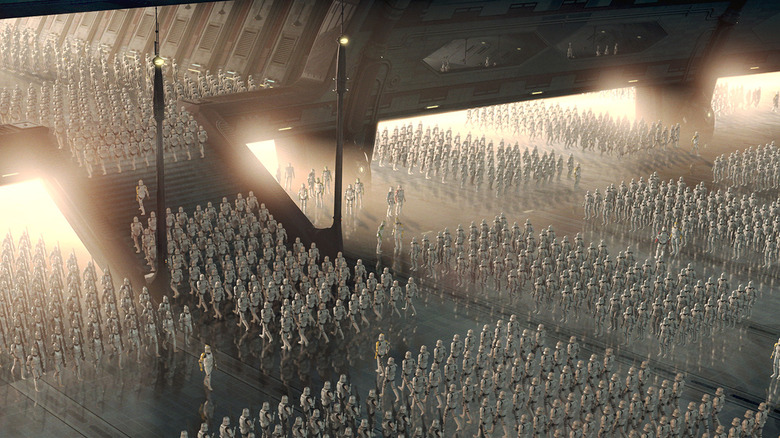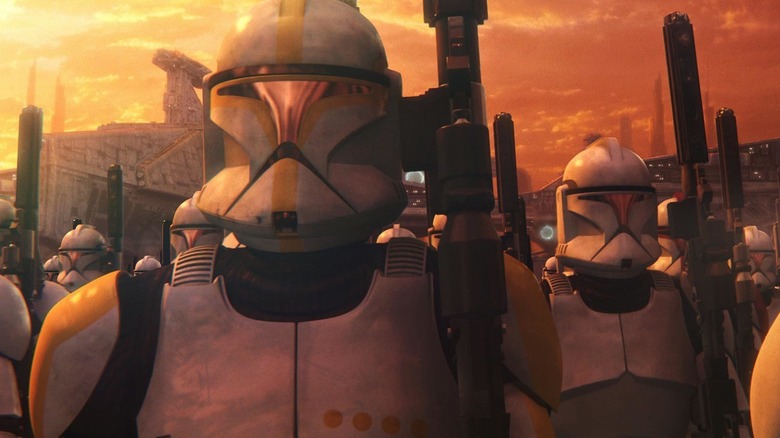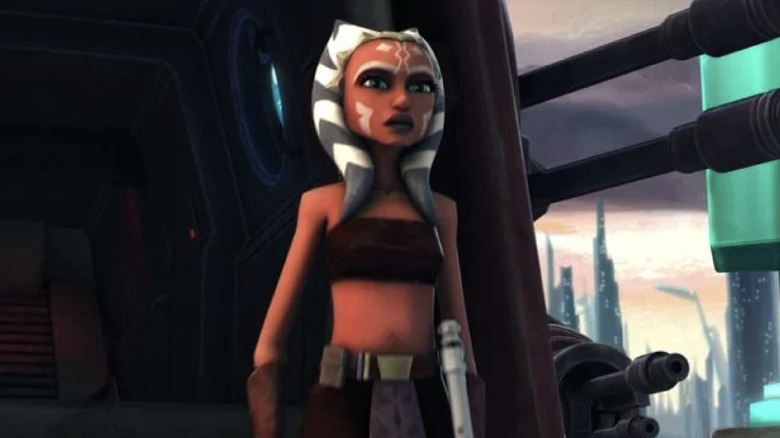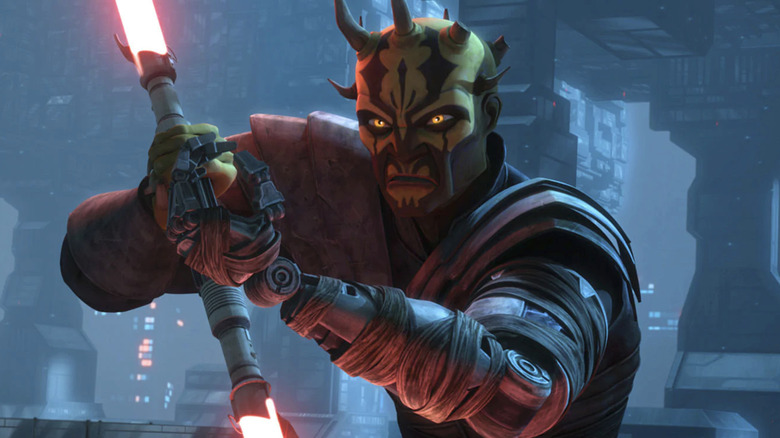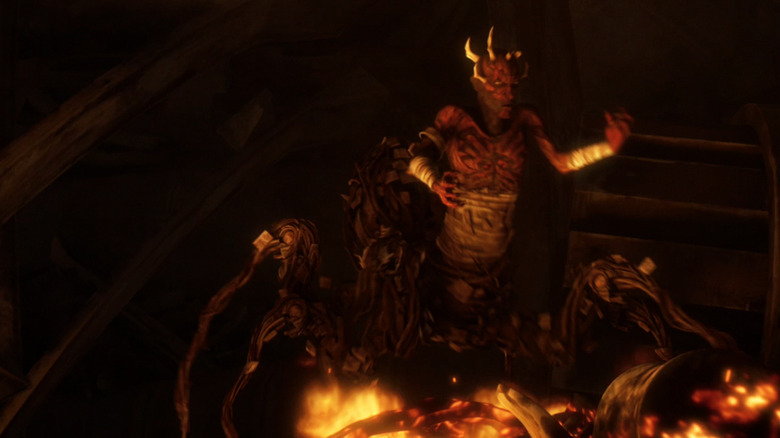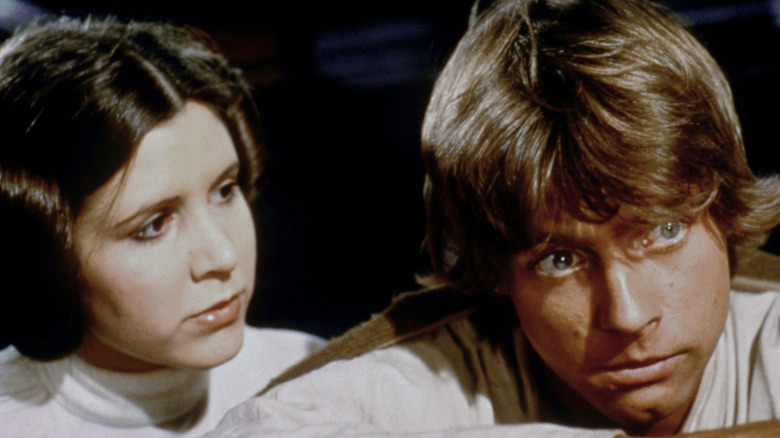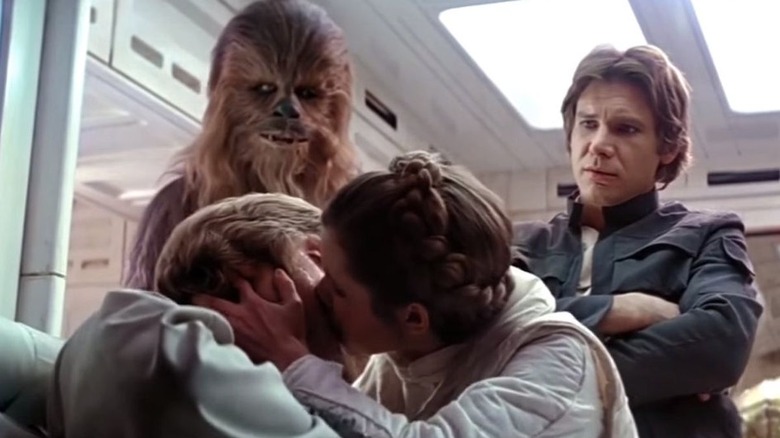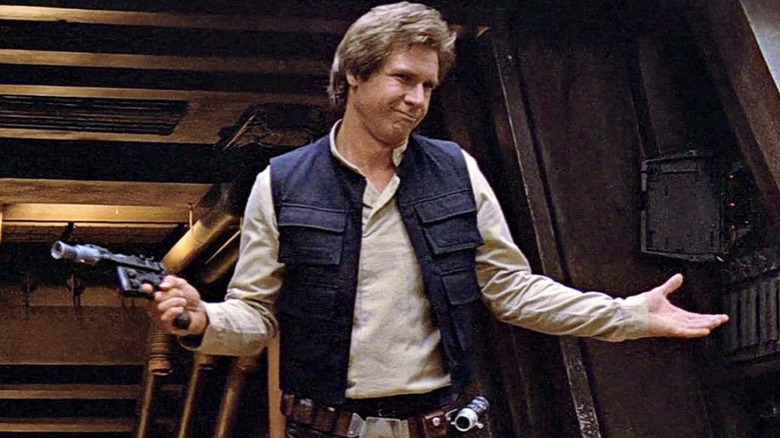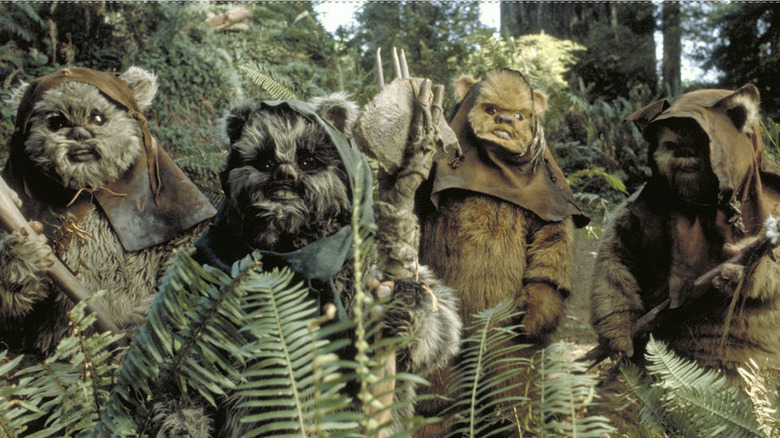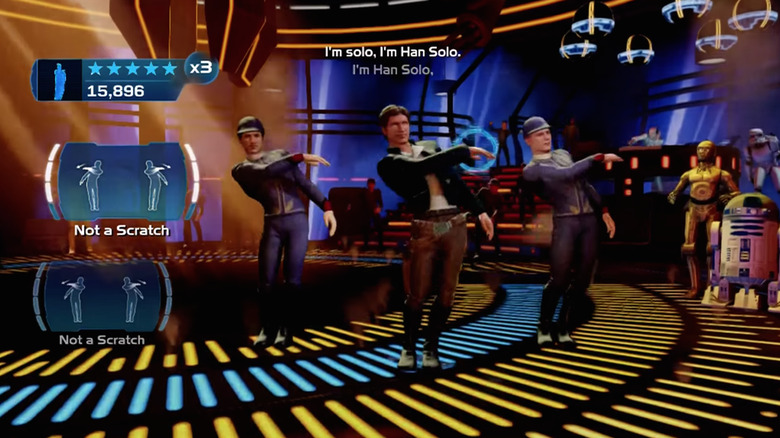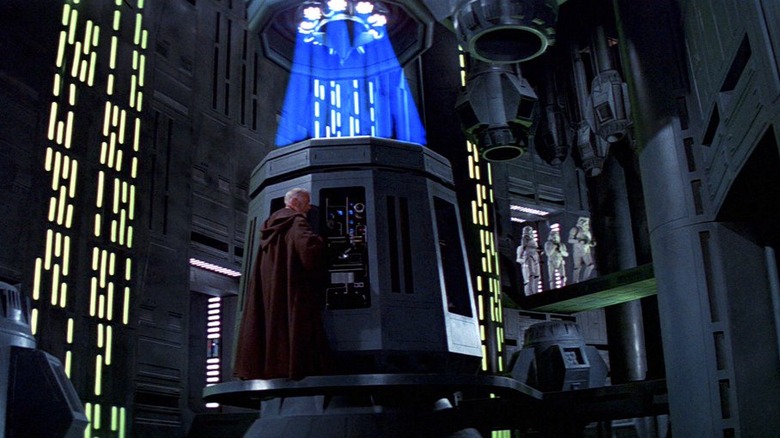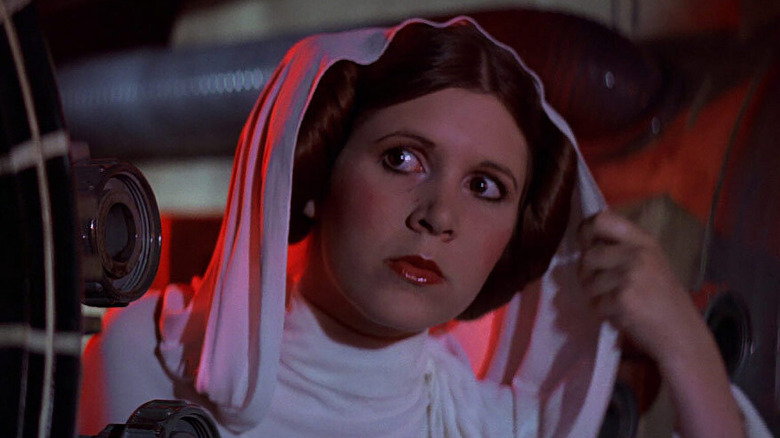Questionable Things We Ignore In The Star Wars Franchise
Ever since it debuted in 1977, Star Wars has remained fully embedded in the hearts, minds, and imaginations of millions of fans all over the world. It has spawned a multitude of films and television series, countless books and comics, and numerous video games. With a franchise that has lasted so long, however, it should come as no surprise that some rather questionable aspects have crept in along the way.
Some of these aspects have been explained away, like the first Death Star's glaring weakness was in "Rogue One." Others will either be much harder to write out or are simply inextricable from the narrative.
Whether they are contrived plot points, pained character decisions, or aspects of the films that simply haven't aged well, Star Wars has its share of questionable moments — here are a few that feel as difficult to navigate as piloting the Millennium Falcon through an asteroid field.
Star Wars has zero understanding of scale
When Obi-Wan Kenobi first arrived on Kamino in 2002's "Star Wars Episode II: Attack of the Clones," he was surprised to discover that the Kaminoan cloners had been secretly creating a Grand Army of the Republic comprised entirely of clones. He was likely even more surprised to learn that there were only "200,000 units ... ready, with a million more well on the way," because that is nowhere near the amount of soldiers the Republic would need to fight a galactic war.
To put this into perspective, the United States alone has over a million people within its military; one nation on one planet has a military larger than the clone army that is supposed to be intended to save the Republic. Considering the fact that there are hundreds of planets that must house at least a trillion sentient beings at bare minimum (and the difficulty keeping them behaving, as depicted in "The Mandalorian"), Star Wars' issue with scale becomes abundantly clear. The numbers are just too small.
The Jedi have no problem using a slave army
Star Wars has often been described as a morality tale, and the "Star Wars: The Clone Wars" animated series took this so far as to open every single episode across its seven seasons with a short inspirational quote or proverb. One thing the franchise has never really addressed, however, is that the show's beacons of morality — the famed Jedi Knights — had no qualms with using a literal slave army.
"The Clone Wars" goes out of its way as early as its second episode, "Rising Malevolence," to impress upon viewers that the clones are people and are not expendable. However in "The Deserter" (Season 2, Episode 10), it is made clear that clones who refuse to fight are considered deserters to be arrested on sight. The clones have no say in whether or not they fight or what they fight for, and they are not allowed to leave.
That's called slavery — and the fact that "The Clone Wars" never addresses it is one of the show's greatest failings.
Ahsoka Tano's inappropriate original costume
When Ahsoka Tano was first introduced in 2008's "Star Wars: The Clone Wars" animated film as Anakin Skywalker's new apprentice, she was immediately divisive among fans for her snippy attitude, snarky dialogue, and potentially irksome characteristics. One aspect of the character that was not debated nearly enough, however, was her original outfit.
Essentially a tiny tube top with leggings, the outfit was incredibly inappropriate. Even if audiences were to look past the notion that Ahsoka was constantly under fire in war zone after war zone with most of her skin bare (and that she's wearing this outfit in a kids cartoon), it's disturbingly creepy that the character wearing it was supposed to be only 14 years old. She was literally a child.
"Savage Oppress" and other Star Wars names
Names have always been a strange beast in the land of the Star Wars. In one moment, audiences can hear the most esoteric of names like Obi-Wan Kenobi, Qui-Gon Jinn, or Padmé Amidala, other times they might hear half-conceived names like Salacious Crumb and Droopy McCool, and in the next they might hear the most shockingly standard of names like Luke and Ben. Though it makes sense that a galaxy would have an appropriately diverse and strange combination of names, it doesn't make hearing them together any less jarring, and nowhere is this more evident than with the franchise's villains.
The Sith Lords are famous for being named after evil-related words like Count Dooku's sith name, Darth Tyranus (like tyranny or tyrant) and Emperor Palpatine's Darth Sidious, but they don't always get a name that sounds even that subtle. In the "Star Wars: The Clone Wars" episode entitled "Monster" (Season 3, Episode 13), a character named "Savage Opress" was explained to be the brother of Darth Maul and the new apprentice of Asajj Ventress. While most Star Wars villain names are at least slightly altered to make them sound more alien, Savage Opress is literally just the words "savage" and "oppress" said with a vaguely French accent.
Darth Maul as a giant spider
At the end of 1999's "Star Wars Episode I: The Phantom Menace," Darth Maul was cut in half by Obi-Wan Kenobi's lightsaber and sent hurtling down a shaft that was so deep audiences could not see the bottom. Like Palpatine, however, somehow he returned. How Maul managed to survive that fate could earn an article all by itself, but what makes the whole situation even more interesting is that, unlike Palpatine, Maul returned in the "Star Wars: The Clone Wars" episode entitled "Brothers" (Season 4, Episode 21), sporting a massive cybernetic spider-body as a replacement for his lost legs.
The legs were rather quickly replaced with more conventional human appendages, but the look overall was simply ... bizarre. Why a spider and why so large? The world may never know the answer, but thankfully fans don't have to look at the monstrosity anymore.
That time Leia comforted Luke
In the world's first foray into the Star Wars universe, Princess Leia Organa of Alderaan could only watch as the Death Star destroyed her home world. Later in that same movie, Luke Skywalker, who had previously discovered the burnt corpses of his adoptive parents, could only watch as Darth Vader cut down Luke's new mentor, Obi-Wan Kenobi. Immediately afterwards, Leia comforts Luke as he mourns the death of Kenobi. Wait, what?
There are a lot of questionable things happening in this scene. First, the movie spends more time showing Luke mourning Obi-Wan's death than it allowed him for the death of his parents. Luke and Kenobi could only have known each other for a few days at most, and yet he seems significantly more affected by the stranger's death than that of his own family. That's pretty messed up.
The real issue, however, is that Luke is being comforted by Leia — the woman who just watched her entire planet be destroyed. Her parents, her family, many of her friends, all of them were destroyed in the blink of an eye, and yet she is the one comforting Luke over the death of a relative stranger.
The scene works just fine in the context of the film if viewers don't think about it too hard — and let's be honest, if "A New Hope" had spent the appropriate amount of time portraying characters mourning, people probably wouldn't still be obsessed with it nearly 40 years later — but if you do get hung up on it, the scene feels very unsettling.
Luke and Leia's kiss
Now, it might seem like the fact that Luke and Leia kiss at all would be prime fodder for this list, considering they're revealed to be siblings in "Return of the Jedi." But this questionable decision is the farthest thing from "ignored" within the Star Wars fanbase. In fact, it's the subject of much disgust and mockery all around the world.
Instead, the questionable aspect of these kisses is that no one else seems to care.
By the events of "Jedi," it's not exactly a secret that they've locked lips. Though no one was around to see them kiss on the Death Star in "Episode IV" (except some stormtroopers), both Han and Chewie were there as Leia kissed Luke again in "Empire Strikes Back" in an attempt to show Han how little she cared for him.
Once everybody discovers they're siblings, why don't they care about how gross this is? For that matter, why don't Luke or Leia seem bothered by their make-out sessions after they discover the same thing? Entire movies like "Say It Isn't So" have been based on the awkward aftermath of a hook-up that turns out too close for comfort. The Star Wars franchise never even gave us scenes of the duo attempting to avoid each other in the hallways of the Millennium Falcon.
Most likely, everyone involved just wants to pretend it never happened. But maybe in a galaxy far, far away this is more of a common occurrence? Perhaps it's best to just move on.
Han Solo is creepy
The big romance in Star Wars' Original Trilogy between Han Solo and Leia Organa might have seemed pretty romantic when it first aired, but over time and repeated viewings, it becomes increasingly clear just how creepy Han is acting throughout "The Empire Strikes Back."
Even setting aside the ten-year age gap, and Leia's status as a teenager when they met in "A New Hope," Han's behavior throughout the sequel is at best childish and immature and at worst sexual harassment.
Not only does he belittle her and mock her throughout most of "Empire," he also repeatedly disregards consent and ignores her every time she says "no" and objects to his advances, flirtations, and innuendos. If that wasn't bad enough, however, their "big kiss" in the story only happens because Han corners Leia alone in a dark corner of his starship while they're temporarily stranded inside of an asteroid in deep space. John William's romantic score can play as loudly as it likes, but it doesn't make the scene (or Han) any less creepy.
Wait, did those Ewoks just EAT people?!
When Luke, Han, and Chewbacca first meet the Ewoks, they discover the indigenous species of Endor isn't as cute as it at first seems.
Though they may look like cuddly little teddy bears, the first thing they decide to do is sacrifice the trio of rebels to their new golden god by roasting them alive over an open fire. In addition to being an incredibly grisly way to execute prisoners, the uncomfortable implication is that these cuddly little creatures were planning to eat the movie's heroes.
In case attempted torture and death weren't enough, the Ewoks do seem to finally get their wish during the final scenes of "Return of the Jedi." With the second Death Star destroyed and the Imperials defeated, the Ewoks are glimpsed using rows of Stormtrooper helmets as drums and audiences are not told how they acquired them.
Though it's perfectly plausible that they simply took the helmets from prisoners or corpses, there is a chilling third possibility. Let's just say that if they ever make another Hannibal Lecter film, we know which Star Wars characters could cross over.
Kinect Star Wars' infamous dancing
There are, throughout the universe, hidden corners which can breed the most horrifying creations in existence. One of those corners is Earth, and one of those creations is the Kinect Star Wars' "Galactic Dance Off" game mode.
Now, this is rather embellished, but it's done to cope with some of the laziest, most cringe-inducing "parodies" that have ever been produced. The most famous of these covers is "I'm Han Solo," an alternate rendition of Jason Derulo's 2010 song, "Ridin' Solo," that features Han Solo dancing inside of the carbonite freezing chamber. Not exactly the happiest location for a light-hearted dance.
The track is lazy, its lyrics are unimaginative, and the dancing is incredibly basic. Tack on a poorly implemented Star Wars aesthetic, and gamers received such "hits" as a "Y.M.C.A." parody titled "Empire Today" and a parody of Gwen Stefani's hit song, "Hollaback Girl," titled "Hologram Girl." Unsurprisingly, this game did not sell well.
The Star Wars universe clearly has no OSHA requirements
In the real world, many countries have organizations like the United States' "Occupational Safety and Health Administration" that create and enforce rules so that people are provided safe working environments and conditions. Star Wars clearly doesn't have an equivalent.
In the very first Star Wars movie, Old Ben Kenobi is forced to shimmy around a large column using the slimmest walkway imaginable in order to turn off the reactor powering the Death Star's tractor beam. There are no railings, few handholds, and a bottomless chasm to fall into if he slips. This wasn't even Kenobi's first time dealing with situations like this.
In "The Phantom Menace," Kenobi was forced, alongside his master Qui-Gon Jinn, to fight the fierce Darth Maul inside of an intricate reactor room with crisscrossing pathways that were all suspended, without hand railings, over more chasms of doom. This has become such an accepted part of the Star Wars universe that the creators of "The Mandalorian" even decided to poke fun of it in the show's second season during its fourth episode, "The Siege." And as Kevin Smith famously pointed out in "Clerks," the lives of Star Wars builders and contractors seem to come with many occupational hazards.
Star Wars' troubled history with female characters
Despite how beloved George Lucas' original saga was and remains to this day, episodes I – VI drop the ball in one key area: the female characters. Though each trilogy does have a strong woman in its core cast, almost all those movies fail to pass the "Bechdel Test" — a metric measuring whether a film has more than one female character, whether the female characters speak with each other, and whether they speak to each other about something other than a man.
It's a frustratingly low standard that many films still fail to pass even today — and Star Wars films are no exception. In fact, only the Disney Era films pass the Bechdel Test. "Star Wars Episode VII: The Force Awakens" was the first Star Wars film to ever meet this simple standard. In the initial six movies, there simply weren't enough female characters with speaking roles to actually manage it. For example, there isn't a single female Jedi with lines of dialogue anywhere in George Lucas' original six-part saga.
